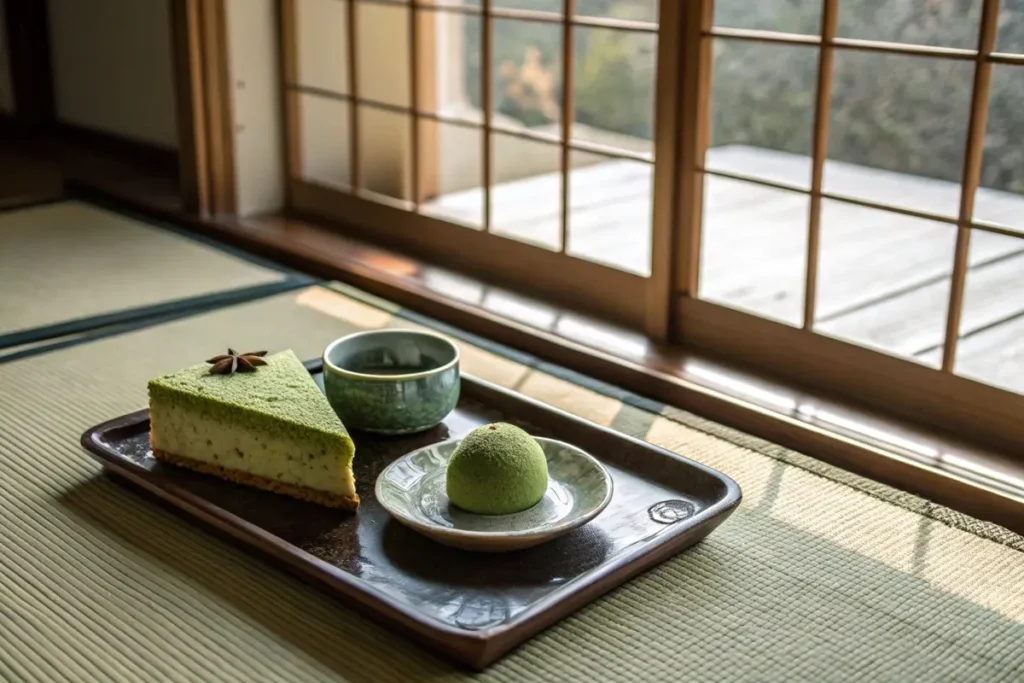Introduction
There’s an enchanting simplicity and elegance to recipes for japanese desserts. From pillowy mochi to creamy purin, Japan’s sweet confections offer a blend of tradition, innovation, and artistic flair. If you’ve ever wondered what is Japan’s most popular dessert, the list can be long—dorayaki pancake sandwiches, matcha-infused roll cakes, fruit-based jellies, and more. Each treat reflects a cultural emphasis on seasonality, balanced sweetness, and impeccable presentation.
Why explore japanese dessert recipes? For one, many are surprisingly easy to make at home with accessible ingredients like azuki beans, sweet rice flour, and matcha powder. Others may require special techniques, but the results—perfectly chewy mochi or a layered matcha parfait—are worth the effort. These desserts also pair beautifully with green tea, further enhancing their subtle, refined taste. And for those intrigued by traditional Japanese sweet culture, from festival kakigori shaved ice to the national love of sweet bean paste, creating these recipes is a delicious way to connect with Japan’s culinary heritage.
Looking to expand your sweet repertoire? Visit our Traditional Japanese Desserts Recipe compilation, where you’ll find approachable methods for time-honored confections. In this article, we’ll delve into essential ingredients, highlight popular desserts across Japan’s four seasons, and provide practical tips for mastering these sweets in your own kitchen. Let’s begin this journey into Japan’s dessert realm—where artistry and balance converge to craft delectable, unforgettable treats.
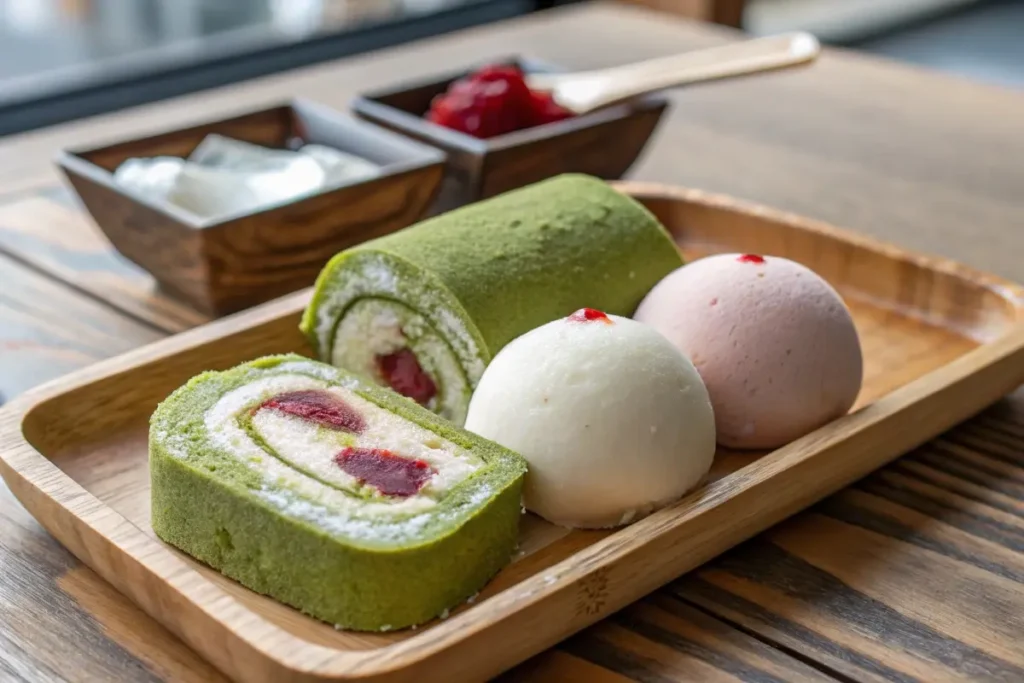
1. Understanding Japanese Desserts
1.1 The Two Worlds: Wagashi and Yōgashi
When exploring recipes for japanese desserts, you’ll notice they split into two main categories:
- Wagashi (和菓子): Traditional confections typically made from plant-based ingredients like azuki beans, rice flour, and agar. These sweets—mochi, yokan, dango—often appear in tea ceremonies and seasonal festivals.
- Yōgashi (洋菓子): Western-influenced pastries adapted to Japanese tastes. Think of matcha cheesecakes, roll cakes, and airy soufflé pancakes.
Wagashi emphasize natural sweetness and artistry, while yōgashi incorporate techniques from French, German, or American baking, yet often reduce sugar and portion sizes to align with local preferences.
1.2 Emphasis on Seasonal Produce
A hallmark of japanese sweet food is seasonality. Chefs and home cooks align flavors with the time of year:
- Spring: Sakura mochi with pink rice or sakura-flavored confections.
- Summer: Refreshing fruit jellies or kakigori shaved ice topped with sweet syrup.
- Autumn: Sweet potato and chestnut–based treats. Check out our Japanese Sweet Potato Dessert for easy ways to incorporate this fall favorite.
- Winter: Cozy, warm anko-filled pastries, often enjoyed with hot tea.
1.3 Subtle Sweetness and Balanced Portions
Though “dessert” can often be associated with rich, sugary indulgence, japanese desserts favor mild sweetness. The aim is to highlight the natural taste of beans, tea, or fruit rather than overshadow them with sugar. Additionally, smaller portions encourage mindful savoring over overindulgence.
1.4 Core Ingredients
- Azuki Beans (Sweet Bean Paste): Boiled and sweetened beans ground into anko, used in mochi fillings, dorayaki, taiyaki, and more.
- Rice Flour (Mochiko or Shiratamako): The basis for mochi’s characteristic chewiness.
- Matcha (Powdered Green Tea): Infuses cakes, cookies, and even soft serve with a distinctive earthy flavor.
- Kanten (Agar): A seaweed-based gelling agent, forming jellies like yokan—firmer and often more vegetarian-friendly than gelatin.
1.5 The Role of Tea
Many recipes for japanese desserts are meant to be paired with tea. Matcha or sencha’s slight bitterness offsets the gentle sweetness of wagashi, creating an elegant harmony. This interplay fosters a ritualistic, mindful dessert experience, whether you’re sitting in a formal tea ceremony or relaxing at home.
1.6 Finding or Making These Desserts
- Confectionery Shops: Traditional wagashi stores, often centuries old, can be found near temples or in historical city quarters.
- Convenience Stores (Conbini): Modern staples like purin, mochi donuts, and matcha Swiss rolls at budget-friendly prices.
- Home Cooking: Eager to replicate these flavors? Check out our Japanese Dessert Recipes for instructions on dorayaki, mochi, and more. Perfect for novices and experts alike.
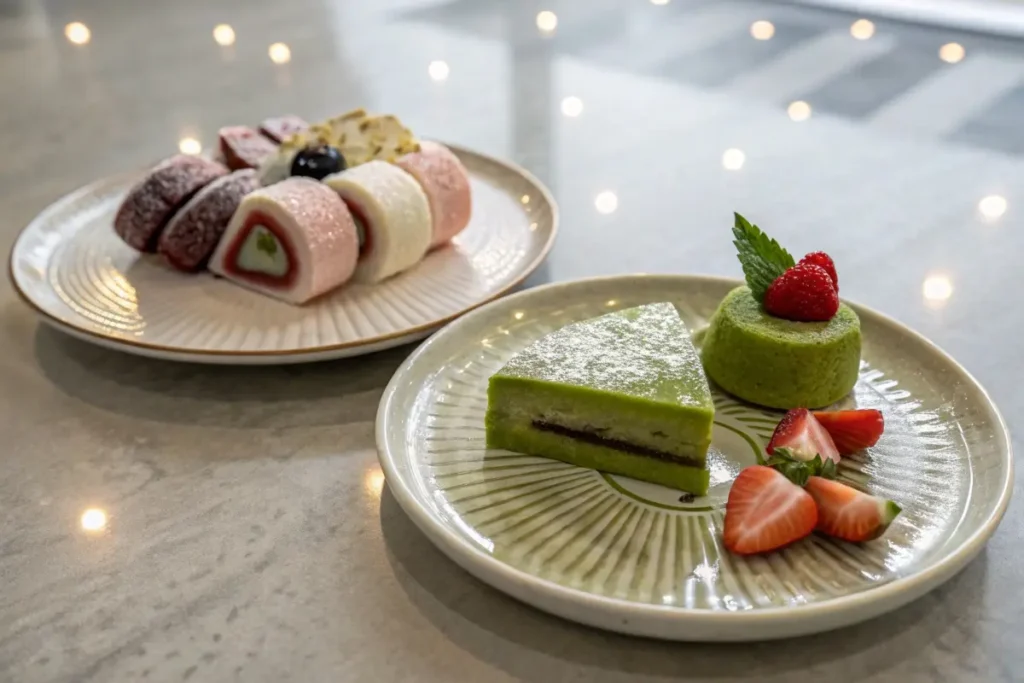
2. Essential Ingredients and Tools
2.1 Azuki Beans and Anko
Central to many recipes for japanese desserts, anko paste can take two forms:
- Koshi-an: A smooth, sieved paste. Perfect for filling mochi or layering in matcha cakes.
- Tsubu-an: A coarser version with bean skins for texture. Common in dorayaki and taiyaki.
Tip: Making anko at home requires soaking azuki beans, then simmering them with sugar. If you’re short on time, store-bought anko is widely available at Japanese grocery stores or online.
2.2 Mochi Flour Variants
- Mochiko: A glutinous rice flour well-suited for daifuku mochi or dango.
- Shiratamako: Another refined glutinous rice flour variety, often yielding smoother textures.
- Dango vs. Daifuku: Dango is typically boiled, shaped into balls, and skewered. Daifuku is stuffed mochi, made by steaming or microwaving the dough before shaping around a filling.
2.3 Matcha and Related Powders
- Matcha: Stone-ground green tea powder, prized for both taste and antioxidants.
- Kinako: Roasted soybean flour, dusted on mochi or used in some cookies. Nutty, lightly sweet flavor.
- Hoji-cha Powder: Roasted green tea variant, less common but adds a smoky twist to creams or cakes.
2.4 Agar (Kanten) for Jellies
Derived from algae, agar (or kanten) sets firmer than gelatin, a staple for yokan or fruit-based jellies. This vegetarian-friendly thickener can craft elegant, translucent sweets with minimal fuss.
2.5 Tools and Equipment
- Mochi Mortar & Pestle (Usu & Kine): Traditional mochi pounding, though modern versions often rely on microwaves or stand mixers.
- Bamboo Matcha Whisk (Chasen): Essential for whisking matcha lumps away.
- Molds and Rolling Mats: For shaping mochi, roll cakes, or layered jellies.
Pro tip: Explore how sweet potatoes also factor into Japanese desserts by glancing at our Japanese Sweet Potato Dessert ideas. These starchy wonders blend well with sugar and warm spices, forming pies, bars, or mochi fillings.
2.6 Balancing Sweetness
Unlike many Western cakes that rely on heavy frostings or sugary fillings, japanese dessert recipes typically use less sugar, focusing on the ingredient’s intrinsic flavor. Chefs or home cooks often measure sweetness in small increments, tasting along the way. You can always garnish with extra toppings—like condensed milk or caramel—for those craving more sweetness. But the essence remains: let natural flavors, not sugar, stand at the forefront.
External Tip: For more scientific insight on sugar reduction in desserts, see the research compiled by Harvard T.H. Chan School of Public Health. They highlight the benefits of moderate sugar usage aligning with Japanese dessert principles.
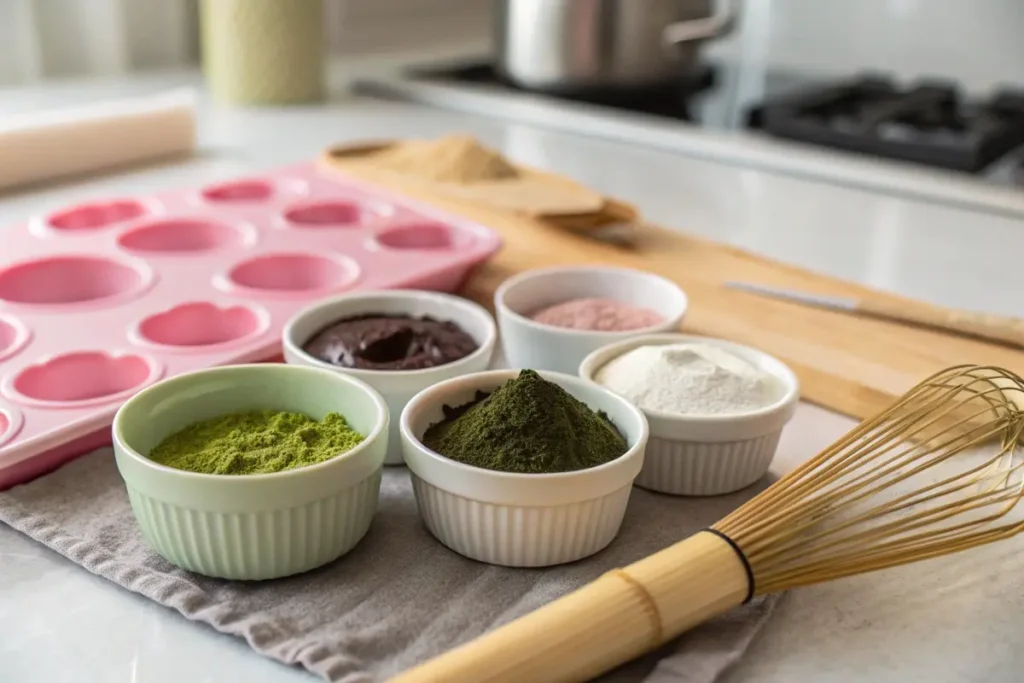
3. History and Context
3.1 Ancient Roots
Japan’s early sweet tradition emerged from a combination of local staples—rice, fruits, and eventually minimal sugar derived from plants. Ceremonial offerings of mochi or fruit signified blessings or festivity. When Buddhism spread, sweet confections often accompanied tea rites, reinforcing the cultural significance of dessert as more than mere indulgence.
3.2 Sugar and Trade (Edo Period)
By the Edo period (1603–1868), improved sugar imports made wagashi flourish. Skilled artisans near Edo and Kyoto refined mochi, anko, and agar-based sweets, producing daifuku, yokan, and ohagi, each reflecting local tastes. The tea ceremony also shaped wagashi aesthetics: sweets had to complement bitter matcha, fostering subtle sweetness and dainty presentation.
3.3 Western Influences and Evolution (Meiji to Showa)
The Meiji Restoration (1868) ushered in Western pastries—sponge cakes, custards, chocolates. Over time, these merged with Japanese flavors:
- Castella introduced from Portuguese influences, adopted widely in Nagasaki.
- Cheesecakes later reinterpreted as airy, less sweet versions.
- Purin evolved into a household pudding with a caramel top.
By the early 20th century, conbini stores sold single-serve sweets. Home baking soared, bridging wagashi fundamentals with modern pastry techniques. This melding of East and West set the stage for matcha roll cakes, mochi donuts, and other hybrid confections we see today.
3.4 Current Trends and International Recognition
Japan’s dessert scene continues evolving. Social media popularizes flamboyant creations—towering parfaits, rainbow mochi ice cream, cat-shaped pastries. Meanwhile, classic wagashi shops persevere, preserving centuries-old recipes. Worldwide, recipes for japanese desserts gain traction among food enthusiasts exploring minimal-sugar or exotic flavor options.
If you’re keen on immersive sweet experiences, consider a Japanese tea dessert approach—like pairing wagashi with freshly whisked matcha. We detail more of these traditions in our Japanese Tea Dessert guide. Ultimately, the story of japanese desserts is one of resilience and reinvention, weaving local resources, external inspirations, and careful craft to shape a dessert culture revered at home and abroad.
4. Practical Examples/Use Cases
4.1 At-Home Mochi Party
Scenario: You plan a small gathering with friends who love trying new desserts.
- Approach: Set up a mochi station. Provide sweet bean paste, fruit, or whipped cream as fillings. Let each guest shape daifuku mochi.
- Outcome: A hands-on, interactive dessert experience. Everyone learns how easy mochi-making can be using microwave or stovetop methods.
4.2 Cafe Menu Diversification
Scenario: A local café wants to stand out.
- Approach: Introduce matcha roll cake slices, a “sweet potato Mont Blanc,” and a mochi doughnut. Market them as “light, artisanal, globally inspired.”
- Benefit: Expands customer base to include dessert enthusiasts or curious travelers who crave authentic Japanese flavors.
4.3 Family-Friendly Weekend Activity
Scenario: Teaching kids about global cuisines.
- Approach: Make simple dango—three colored dumplings on a stick. Let kids help color each dough portion with matcha, strawberry powder, or plain. Then grill or boil, top with sweet soy sauce.
- Upshot: A creative bonding moment that fosters interest in recipes for japanese desserts. The outcome is a sweet-yet-educational treat.
4.4 Easy Bento Dessert
Scenario: You want a small sweet for a bento lunch.
- Approach: Pack a slice of matcha cheesecake or a single daifuku mochi in a sealed container.
- Why It Works: Japanese desserts often fit well in compact portions, complementing savory lunches. Balanced sweetness ensures you won’t feel weighed down the rest of the day.
To expand your repertoire with more unique sweets, Discover Japanese recipes for everything from soups to desserts—helpful if you want a complete menu. By integrating these dessert ideas in daily life—be it a social event or a simple midday treat—you’ll find how seamlessly recipes for japanese desserts can elevate your culinary routine.
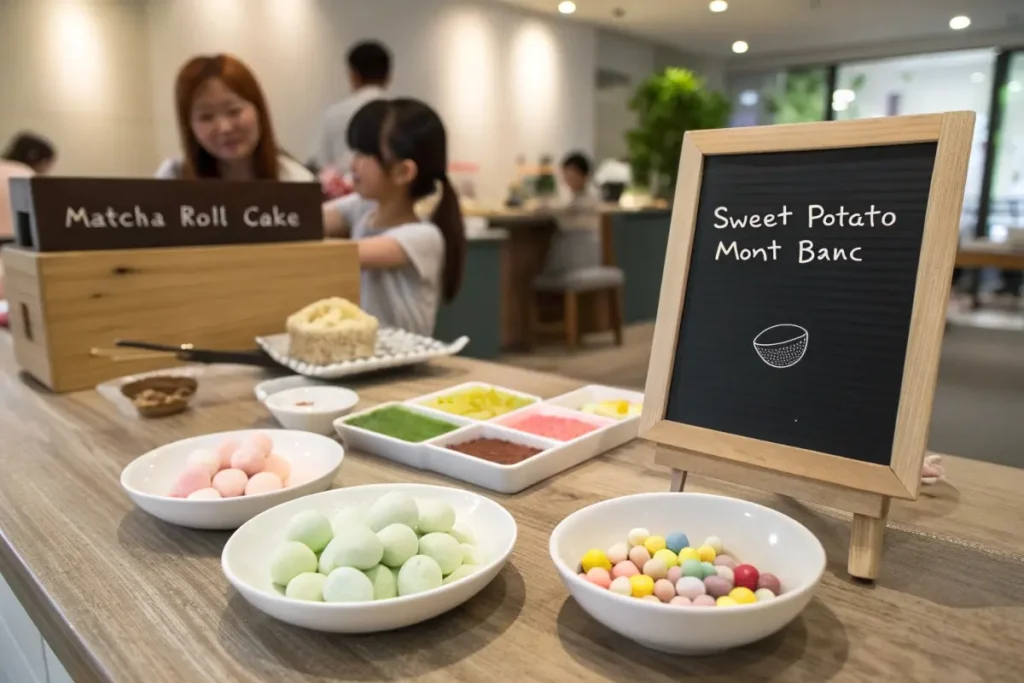
5. FAQs
5.1 What is Japan’s most popular dessert?
It depends on region and personal taste, but mochi-based sweets (like daifuku) and matcha confections rank highly. Taiyaki stuffed with anko or custard is also cherished. In bigger cities, fluffier Western-inspired treats (soufflé pancakes, matcha cheesecakes) often attract big crowds.
5.2 What is a traditional Japanese sweet?
Wagashi in general, especially items like mochi, yokan, and anko-filled pastries, represent the essence of traditional Japanese sweet. Rooted in centuries-old techniques, they emphasize minimal sugar, natural flavors, and symbolic shapes referencing nature or seasons.
5.3 What is a popular dessert served in Japan during the summer months?
Kakigori (shaved ice) drizzled with syrup or condensed milk is the summertime star. Variations include matcha kakigori topped with azuki beans or fruit jellies. The ephemeral nature of shaved ice fits Japan’s concept of fleeting seasonal enjoyment.
5.4 What is the most popular pastry in Japan?
Soufflé pancakes gained massive global attention for their airy, jiggly texture. Another contender is the classic Japanese cheesecake, known for being light and cloud-like. Both reflect Japan’s preference for gentle sweetness and refined mouthfeel.
5.5 Are these desserts hard to make at home?
Not necessarily. While advanced techniques (like nerikiri wagashi sculpting) can be tricky, simpler options—dorayaki, mochi, or matcha cookies—are quite accessible. Our Japanese Dessert Recipes provide step-by-step guidance for novices and experienced bakers alike.
5.6 Do I need special ingredients?
A few staples—like glutinous rice flour (mochiko), anko paste, or matcha powder—might require a visit to an Asian grocery or online store. Once acquired, you’ll find the recipes straightforward. Tools like a bamboo matcha whisk or mochi steamer are optional but helpful.
5.7 How can I incorporate these sweets into daily life?
Serve small portions as an afternoon pick-me-up, pair them with tea, or integrate them into a multi-course meal. Mochi ice cream or fruit-based jellies can double as refreshing, light desserts. For frequent dessert fans, rotating through seasonal produce keeps it exciting and aligned with Japanese culinary customs.
Conclusion
Recipes for japanese desserts open the door to a vast, captivating world—where mochi’s chewy texture meets the velvety tang of matcha cheesecake and where seasonal produce transforms into elegant confections. Whether you’re aiming to replicate classic wagashi or experiment with Western-inspired sweets showcasing local flair, Japanese dessert-making offers both a cultural lesson and a creative outlet.
To begin, gather core ingredients like azuki bean paste, glutinous rice flour, and matcha powder. Start with approachable favorites—perhaps a simple dorayaki pancake or daifuku mochi. Once comfortable, explore advanced wagashi shapes or layered parfait techniques. For continuous inspiration, see our Japanese Dessert Recipes, which guide you from basic dango to sophisticated matcha roll cakes.
In essence, crafting recipes for japanese desserts means engaging with a sweet tradition grounded in seasonal awareness, careful proportioning, and an eye for beauty. Each dessert invites you to slow down, savor subtle tastes, and appreciate the interplay between sweet bean paste or tea’s subtle bitterness. By merging tradition with personal flair, you’ll bring Japanese sweetness into your kitchen—and delight anyone who tastes the result.
